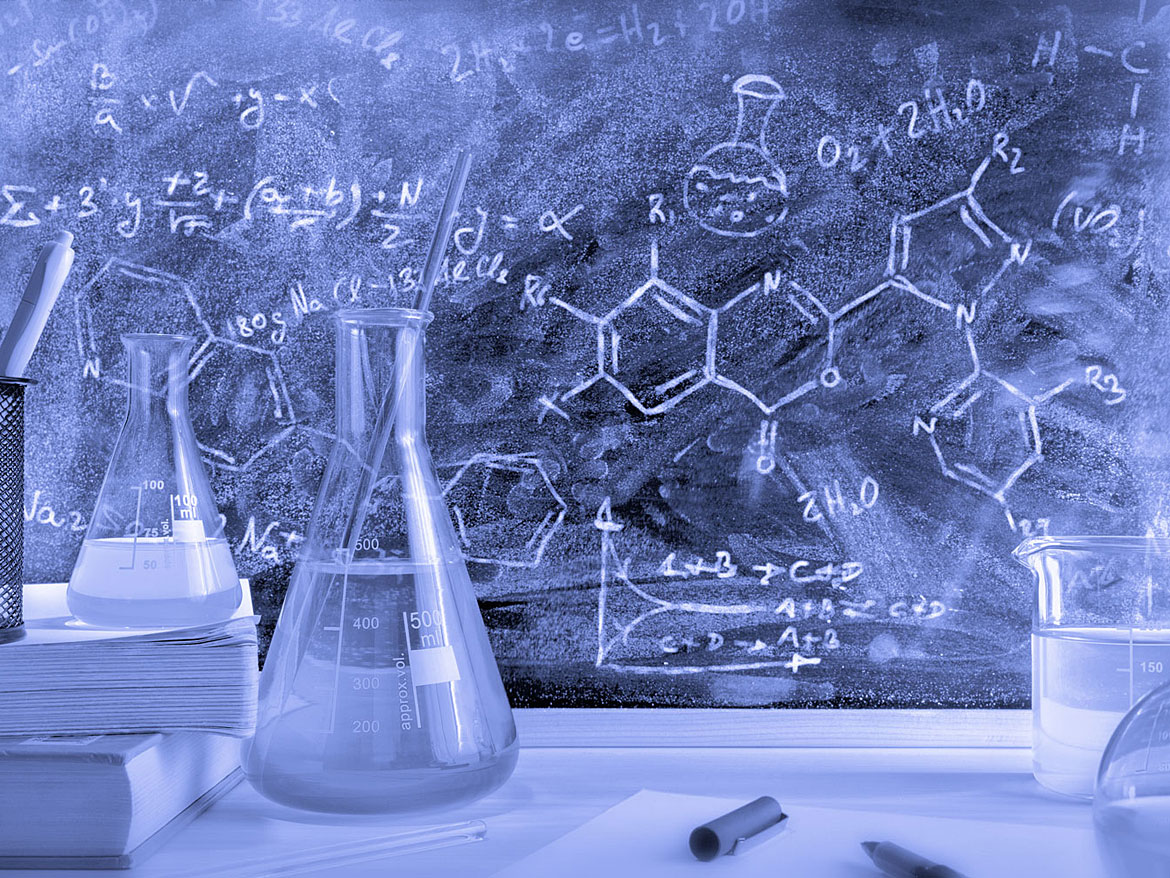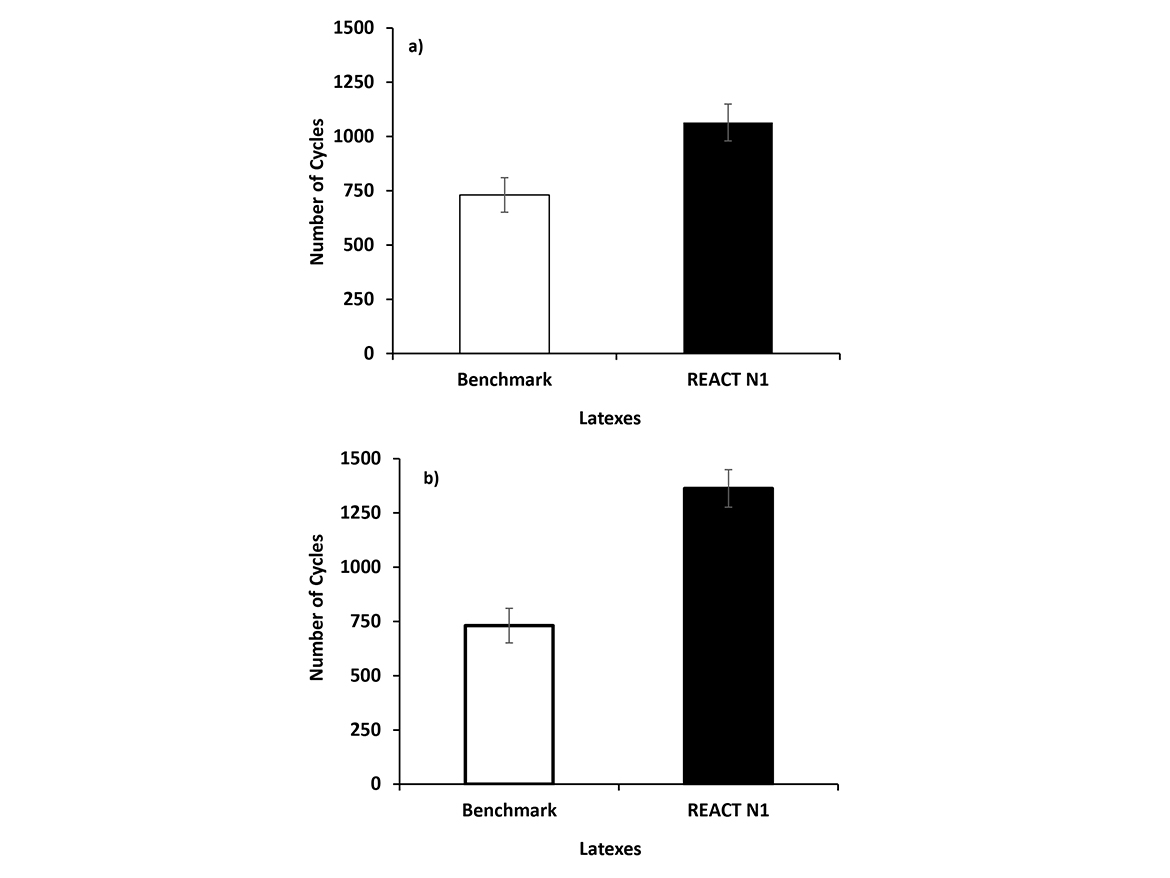Improving Water Resistance of Water-Based Coatings Using Reactive Surfactants, Part 5

Davizro / iStock / Getty Images Plus, via Getty Images.
Continuing from the previous four articles in this series, we will conclude the work on using reactive surfactants to make styrene acrylic emulsions with better water resistance.
The wet scrub resistance of paint with PVC of 30% formulated with the emulsions from Formulations 7 and 8 is presented in Figure 1. The results shown in Figure 3b from Part 4 of this series and Figure 1 below suggest that paints formulated with latexes from Formulations 6 and 7 polymerized at 80/60 °C and at 80 °C, respectively, presented similar wet scrub resistance, 50% higher than the benchmark latex. On the other hand, paint formulated with the latex from Formulation 8 (Figure 1b), polymerized at 60 °C, presented an increase in wet scrub resistance of almost 90 wt% in comparison to the benchmark latex despite having incorporated content of REACT N1 into latex particles of almost 70%, which was similar to the content of REACT N1 incorporated into latex particles from Formulations 6 and 7.
The reasons for this increase in the wet scrub resistance of paint formulated with latex from Formulation 8 are still under investigation, but a 20-50% increase in wet scrub resistance was also observed in paints formulated with all-acrylic latexes polymerized at low temperature with the redox initiator used in the polymerization of latex from Formulation 8.5

Conclusions
The reactive non-ionic surfactant investigated in this work presented surface activity similar to conventional surfactants.
Process 1 generated emulsions with particle size in the range of 100 to 140 nm while using content of the reactive non-ionic surfactant in the range of 3 to 5 phm. Incorporation of the reactive non-ionic surfactant in those latexes was around 70 wt%, and the increase in the wet scrub resistance of paints was around 60% in relation to the benchmark styrene-acrylic latex.
Process 2 without post-addition of conventional anionic surfactant generated emulsions with limited stability and particle size close to 100 nm while using the content of the reactive non-ionic surfactant of 2 phm. Process 2 with post-addition of conventional anionic surfactant generated stable latexes with particle size in the range of 80 to 90 nm while using contents of the reactive nonionic surfactant of 2 phm and conventional anionic surfactant of 0.4 phm.
Styrene acrylic emulsions obtained from Process 2 presented an incorporation of the reactive non-ionic surfactant that was up to the coverage of the emulsion particles by the conventional anionic surfactant. Due to this, emulsions without post-addition of conventional anionic surfactant presented a higher incorporation of the reactive non-ionic surfactant of 85 wt% while the latexes with post-addition of anionic surfactant presented incorporation of the reactive non-ionic surfactant close to 70 wt%. This post-addition of anionic surfactant also caused a decrease in the wet scrub resistance of the final coatings.
Emulsions obtained from Process 2, with post-addition of conventional anionic surfactant, exhibited an incorporation of the reactive non-ionic surfactant that was not up to the temperature and type of initiator used in the polymerizations. Latexes polymerized at 80/60 °C and 80 °C generated paints with wet scrub resistance about 50% higher than the benchmark styrene-acrylic emulsion. However, paint formulated with latex polymerized at 60 °C using redox initiator presented an increase in the wet scrub resistance of 90% in relation to the benchmark styrene-acrylic emulsion. The reasons for this increase in the wet scrub resistance are still under investigation.
References
1 Vanderhoff, J.W.; Bradford, E.B.; Carrington, W.K. The Transport of Water through Latex Films, J. Polym. Sci. 1973, 41, 155 - 174.
2 Aramendia, E.; Mallégol, J.; Jeynes, C.; Barandiaran, M.J.; Keddie, J.L.; Asua, J.M. Distribution of Surfactants near Acrylic Latex Film Surfaces: A Comparison of Conventional and Reactive Surfactants (Surfmers), Langmuir 2003, 19, 3212 - 3221.
3 Aramendia, E.; Barandiaran, M.J.; Grade, J.; Blease, T.; Asua, J.M. Improving Water Sensitivity in Acrylic Films Using Surfmers, Langmuir 2005, 21, 1428 - 1435.
4 Noyes, N. Non-Leaching Reactive Surfactants for Architectural Latex Binder, PCI, 2018, 34, 36 - 41.
5 Fithian, P.; O’Shaughnessy, M.; Lubik, M.; Mark, S. Redox for Main Polymerization of Emulsion Polymers, PCI, August2017.
All information contained herein is provided "as is" without any warranties, express or implied, and under no circumstances shall the author or Indorama be liable for any damages of any nature whatsoever resulting from the use or reliance upon such information. Nothing contained in this publication should be construed as a license under any intellectual property right of any entity, or as a suggestion, recommendation, or authorization to take any action that would infringe any patent. The term "Indorama" is used herein for convenience only, and refers to Indorama Ventures Oxides LLC, its direct and indirect affiliates, and their employees, officers, and directors.
Looking for a reprint of this article?
From high-res PDFs to custom plaques, order your copy today!




